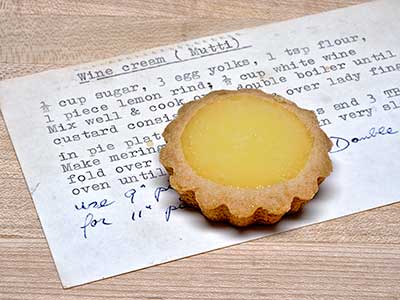January 19, 2015
Mignardise

tarte à la crème de vin
(wine-cream tart)
Don’t ask Wikipedia for a list of pies. The list will be too long to fathom. Still, what are the most common pies in America? Apple certainly. All types of berry and other fruit pies. There’s banana- and coconut-cream pie? In the fall, pumpkin pin. At other times, sweet potato pie. And then there’s lemon-meringue pie.
My mother served a dessert in the 1950s that she called lemon-meringue pie that wasn’t. Instead of a crust, she poured the filling over a single layer of lady fingers and then topped it with the traditional meringue. The lady fingers were a soft American-style, not the hard Italian-style that is common today. The biggest difference between this pie and a true lemon-meringue pie was that the filling was prepared with white wine and not lemon juice. It wasn’t until the 1960s that she would refer to the pie as a “wine dessert” instead of a lemon-meringue pie. As a child, this dessert was not a favorite of mine.
Mom got the recipe—her recipe card is shown in the photo—for the filling from her mother. I do not know if the recipe went all the way back to O’Ma’s finishing-school days in Vienna where she learned to be a “proper” German housewife. Whereas my grandmother would have used a Bavarian white wine, my mother was confined to our local plonk. I remember her keeping a bottle of Italian Swiss Colony Sauterne in the cupboard for cooking. This was a dry wine made, most likely, from Sémillon, Sauvignon blanc, and Muscadelle grapes, not the sweet wine associated with labels like Château d’Yquem.
The crust recipe I used is adapted from one I used earlier for the petits tartes au ganache.
32 g (1⁄4 c)
blanched almond flour
8 g (2 t)
finely granulated sugar
47 g (1⁄3 c)
all-purpose flour
32 g (2 T)
salted butter, at room temperature
1. Preheat oven to 180 °C (355 °F).
2. Place all the ingredients in a bowl. Use the fingers of one hand to bring the mixture together into a smooth dough.
3. Press the dough into mini-tart pans. (Mine are about 4 cm [1-1⁄2 in] in diameter.) Use the tip of your finger to flatten the bottoms and form a well in the dough in each pan.
4. Bake the tart shells until the edges turn golden, about 15 minutes.
5. Upon removing the shells from the oven, press the centers down flat with the end of a dowel.
6. When cool, gently remove the shells from the tart pans.
Yield: About 12 mini-tart shells.
Italian Swiss Colony Sauterne is no longer available. The brand has traversed though a variety of owners, and the old winery ceased operation in 1988. I used a not-too-oaky California chardonnay, but next time I think I’ll use a dry vermouth.
33 g (2-2⁄3 T)
granulated sugar
1 large
egg yolk
1⁄8 t
cornstarch
40 ml (2-2⁄3 T)
dry white wine
1 drop
fir-needle oil [optional]
1. Combine the ingredients in the top of a double boiler set over boiling water. Stir with a rubber spatula until a thick filling is formed.
2. Spoon the filling into the tart shells. Set in your refrigeration to chill.
Note: My mother always refrigerated this dessert. I don’t know why. Everything is cooked. Nonetheless, I still store the finished tarts in my refrigerator.
Yield: Enough filling for about 12 tart shells.
© 2015 Peter Hertzmann. All rights reserved.
